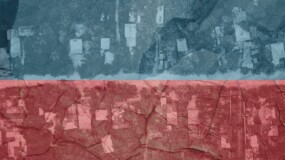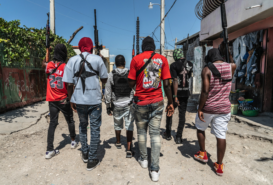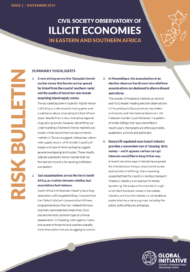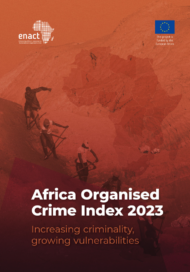Posted on 01 Jul 2025
The deployment of organized criminal gangs by politicians to counter peaceful protests in Nairobi in June has once again raised the spectre of violence in Kenya ahead of the 2027 general elections, threatening peace, cohesion and integration in a country battling to retain its hold on democracy.
On 25 June, organized criminals armed with whips and clubs, and backed by the police unleashed terror on a peaceful march commemorating one year since the historic GenZ uprising against punitive taxes, in which 60 people were killed. A week earlier, on 18 June, the same anarchists, some riding passenger motorcycles (known locally as boda boda), had confronted hundreds of people peacefully demanding the arrest and prosecution of a senior police officer suspected of involvement in the death of 31-year-old teacher and political blogger Alfred Ojwang in police custody.
While the media has widely described them as ‘hired goons’, the attacks were in fact more organized and calculated: these were criminal gangs and hired militias, funded by senior politicians and other individuals. Interviews conducted in Nairobi identified most of the perpetrators as residents of Nairobi’s low-income settlements: Kawangware (home to the Congo Boys), Kayole (base of the Gaza gang), Kware and Kibera (headquarters of the Kibera Battalion).
As the gangsters descended on the streets, the state immediately banned live broadcast coverage of the protests and switched off leading television stations. As well as assaulting and raping protesters, they torched and looted business premises in an attempt to portray the peaceful protestors – who had filled the streets with leaves, twigs, miniature Kenyan flags and placards – as destructive elements pursuing a political agenda. Eighteen people were reportedly killed and hundreds of others were left seriously injured.
Behind these politically sponsored attacks looms the shadow of 2007/8 post-election violence, when 1 500 people were killed and 600 000 displaced in just a month as gangs and ethnic militias unleashed terror across the country. Six Kenyans – among them the current president, William Ruto, and his predecessor, Uhuru Kenyatta – faced charges at the International Criminal Court (ICC) for orchestrating crimes against humanity. However, their cases were later dismissed due to insufficient evidence.
Organized criminal gangs have become a persistent feature of Kenya’s politics. Politicians and their financiers routinely hire these groups to serve as private bodyguards during campaign rallies and to mobilize crowds, disrupt rallies, threaten or assassinate political rivals and election officials, impersonate absentee voters, contest results through violent post-election demonstrations and killings, heckle competitors, stuff ballot boxes, bribe voters and destroy voter cards.
Recent statistics on the number of criminal gangs in Kenya are lacking, but the last count in 2018 revealed exponential growth – from 33 gangs in 2010 to 326 in 2017. They are a symptom of the country’s widespread unemployment and historical injustices, which have produced millions of jobless young people who can be readily hired to serve selfish ends. Nine out of 10 organized criminal gangs in Kenya are involved in politics, either directly or indirectly, or are funded by or established by politicians. Ninety percent of gang activities in Kenya are related to politics.
The interplay between criminal gangs, corruption, and electoral and ethnic violence has become central in discussions regarding the obstacles to democratization in Kenya and the prospects for sustainable development. While some gangs maintain allegiances to specific politicians, gangs-for-hire, who work for the highest bidder, are more common. The Mungiki and Gaza gangs exemplify these political connections, with the former having played a particularly destructive role in the 2007/8 violence.
Following the post-election violence and the subsequent ICC intervention, the role of criminal gangs in political violence appeared to be waning. But June’s events tell a different story: the attacks were unprecedented in scale, described by a senior police officer as a ‘scene from hell’, and have sparked widespread fears about the re-emergence of the relationship between gangs, politicians and law enforcement.
According to a police officer familiar with the Mungiki gang, ‘There were hundreds of them, under instructions to destroy life and property.’ Gang leaders offered their members 2 000 Kenyan shillings (US$15.50) each to participate – with 50 per cent paid upfront. They were also promised the opportunity to loot business premises. A member of the Gaza criminal gang interviewed in Nairobi said that gang leaders earned between Ksh500 000 (US$3 875) and Ksh1 million (US$7 750), depending on the strength of force, for leasing out their ‘manpower’.
Echoes of Haiti
The country is left grappling with fears that state agents and politicians, by instrumentalizing capacity for muscle-for-hire, have inadvertently created a pool of violent youths who risk becoming a national security threat. Indeed, with the police complicit in gang activities, criminal gang members feel protected and emboldened. ‘They now know that their activities can be risk-free. We are going the Haiti way; we have started with whips and clubs, and soon we’ll equip them with guns,’ warned security analyst George Musamali, referencing the Caribbean nation now mostly under the control of criminal gangs. Ironically, it is Kenya that leads the police support mission in Haiti.
Days before the 25 June protests, William Kamket, a legislator and ally of President Ruto, had exhorted youths from his ethnic community at a rally to take up arms and travel to the capital to counter demonstrators. Meanwhile, Nairobi’s county governor, Johnson Sakaja, was forced to publicly deny claims by clerics and opposition leaders that he had paid people a total of Ksh2 million (US$15 500) to counter protests triggered by the death of Ojwang at Nairobi’s central police station. Sakaja instead blamed political rivals for sponsoring the violence.
Election violence in Kenya is currently classified as a petty offence or, at worst, robbery with violence. This leads to convictions of only the rank and file within criminal groups. The financiers and sponsors of violence escape justice because the legal system fails to make the establish connections between the violence and organized crime.
Kenya now stands at a crossroads. It must decide whether to allow the dangerous alliance between politicians and criminal gangs to become more firmly established, or to take decisive action to dismantle these politico-criminal networks before they further undermine the nation’s democratic foundations.



